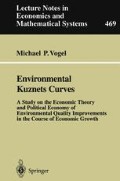Abstract
In section 2.1 a distinction was made between absolute and relative emission reductions. Declining emissions in absolute terms mean that the level of emissions falls over a given period of time, as opposed to declining emissions in relative terms which signify a fall in the emission intensity or the emission per unit of output.47 Environmental Kuznets Curves have been defined as to comprise two intervals of per capita income. In the lower-income interval the absolute pollution level increases with per capita income, and in the upper-income interval it decreases. Provided that the rate of pollution assimilation or decay is constant, the inverted U-curve of pollution must be the result of a similar inverted U-shaped pattern of emission levels (see section 2.5.3). From this it can be inferred that, given a nondeclining population size, Environmental Kuznets Curves automatically imply declining emission intensities of output (or of income) in the upper-income interval.
There is only … People. J. Lovelock
Access this chapter
Tax calculation will be finalised at checkout
Purchases are for personal use only
Preview
Unable to display preview. Download preview PDF.
References
Lovelock (1979), p. 122
In the case of only a single good or sector there are no problems of comparing different emission intensities. The reference unit with respect to which the intensity is expressed (e.g. emissions per ton of physical output, or per dollar worth of output) is more or less arbitrary. With several goods or sectors, however, a common denominator is needed to allow cross-sectoral emission intensity comparisons. Usually the value of one unit of the numeraire good is chosen as reference. For instance, if gross domestic product is the unit of account, then emission intensities express how much emission is associated with a sectoral output that is worth one unit of GDP. Therefore, “output” should henceforth be understood as “value of output” or “output in terms of the numeraire”.
A neoclassical production function implies that production is increasing and strictly concave in both arguments. It follows for its intensive form that.
This assumption resembles the so-called “putty-clay” case of the vintage approach in the earlier theory of economic growth [e.g. Johansen (1959)]. Roughly speaking, it asserts that the capital-labour ratio in production can be chosen more or less freely before production is started. However, once being used in production, factors are fixed, and the formerly substitutional technology becomes limitational. So “putty-clay” stands for ex ante substitutability and ex post limitationality.
This does not mean that all factor prices need to be equal; factor prices can and will differ in this model. It only means that employing one unit of a factor, say C, costs the same, no matter in which sector the factor is used.
Linear homogeneity in production gives rise to scale-independent marginal costs which are called unit costs.
The steps are
Recall that the constancy of &3x03C4; and r in the environment phase has already been pointed out in section 6.2, but based on different arguments.
Author information
Authors and Affiliations
Rights and permissions
Copyright information
© 1999 Springer-Verlag Berlin Heidelberg
About this chapter
Cite this chapter
Vogel, M.P. (1999). Endogenous Environmental Policy and its Effects on a Growing Economy. In: Environmental Kuznets Curves. Lecture Notes in Economics and Mathematical Systems, vol 469. Springer, Berlin, Heidelberg. https://doi.org/10.1007/978-3-642-58517-3_6
Download citation
DOI: https://doi.org/10.1007/978-3-642-58517-3_6
Publisher Name: Springer, Berlin, Heidelberg
Print ISBN: 978-3-540-65672-2
Online ISBN: 978-3-642-58517-3
eBook Packages: Springer Book Archive

